
From Campus Security to Campus State Police
For its first five decades, security for the SUNY-Binghamton campus was provided by an unarmed security patrol force. This came to end throughout the State University of New York system in 1998. The creep towards this objective started in the turbulent 1960s and advanced steadily: a statewide SUNY security force was established in 1968, the jurisdiction of campus officers was extended beyond campus boundaries in 1969, security officers at SUNY Albany were armed in 1974, security officers were designated “public safety” officers in 1978, and the powers of these officers throughout the state were slowly expanded throughout the 1980s. It was in the early 1990s however that legislators floated proposals to transform campus safety officers into a fully-empowered, armed state police force. These years would set the stage for the growing calls today to defund police forces.
Binghamton students and faculty mounted a vigorous opposition over several years. Flyers were posted around campus alerting students that “ULED might get guns. Just thought you would like to know.” In 1992 a coalition of student organizations rallied hundreds against the move, eventually occupying a campus administration building and proposing alternatives forms of safety, including a student patrol, sensitivity training, and a student-faculty oversight board.[1] Pipedream, the campus newspaper, editorialized that “Guns for ULED (university law enforcement) are dangerous for minorities.”[2]
Local officials countered these calls, arguing that the campus needed real police power to fight crime and, especially, the ability to work with and in surrounding cities. The Johnson City Chief of Police and the Broome County District Attorney both advanced the argument that campus officers needed to operate as full-fledged police force on- and especially off-campus. SUNY-Binghamton’s Director of Public Safety railed against regulations that served to “narrowly restrict their law enforcement authority” to campus residents. Even worse, as Binghamton Review, the conservative campus newspaper put it by citing Public Safety:
“We cannot ‘stop and frisk’ potentially dangerous suspects encountered on our campus.”[3]
Black students’ expressed fears about racial profiling and police harassment were, Binghamton’s Press & Sun-Bulletin newspaper editorialized, unwarranted:
“Is it fair to assume that because some cops have mistreated minorities that all cops are prone to? Isn’t that a stereotype like most college professors are Marxists or that most black students are beneficiaries of affirmative action?”[4]
By the mid-1990s the forces pushing mass policing and mass incarceration won this battle: in 1998 Governor Pataki signed into law legislation that created the State University Police force.[5]
Policing Campus Protest
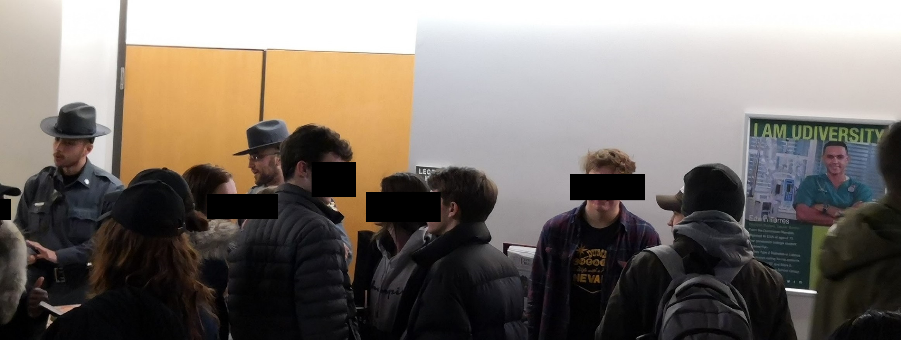
Clashes between students and campus and municipal police forces invariably erupted around campus protests as any number of examples over the years demonstrate. When the white nationalist Student Association President in 1996 closed Student Association meetings to progressive representatives, the campus dispatched ten police to guard the doors. Students rallied to force their way in and campus police intervened with pepper spray and arrests. A sit-in and protest by 800 students followed. An anti-Iraq war march in 2008 also resulted in the use of pepper spray and the arrest of eight students by the Vestal police. Students protested: “You mace a rapist, not students that are protesting.”
In 2016 campus police surrounded the France Beal Society occupiers of the public lobby of the Couper administration building for days on end. Students were protesting campus funding for the City of Binghamton Police Department, which they charged had “continually failed to serve the Black and Brown members of our community.” Funding more police, they contended, would deepen “the divisions between BU students and Binghamton residents, which actually could make our community less safe.” They urged resources be redirected to health services on and off-campus, especially counseling.President Stenger refused to meet with the students, closed all the offices in the building including his own for the duration of the protest, and had officers patrol the corridors inside.
This hardening stance continued into the spring of 2018, when Black graduate student Dominic Davy was threatened with arrest by campus police as he and others passed out leaflets against racism in campus programs and departments. The police were allegedly operating at the behest of administrators under a Dean who refuses, following the campus President, to meet with protestors.
This past November over 200 students once again rallied against the campus police, who had come to the rescue of illegal right-wing tabling on campus. Chanting “Who are you protecting?” and ““No justice, no peace, no racist police,” the predominantly Black group regrouped at an evening teach-in where students spoke to a long history of racial harassment. This protest was followed in the following week by the campus police removing two protestors who had interrupted a speech by the conservative economist Arthur Laffer. The students were hauled from the lecture room to the basement of the building and arrested and charged there— a process watched over by the newly appointed Assistant Vice President for Student Affairs who was also the Chair of the new Town and Gown Committee, which had been formed to diffuse the demands of Frances Beal Society. The next week President Trump denounced Binghamton’s protesting “mobs.”[6]
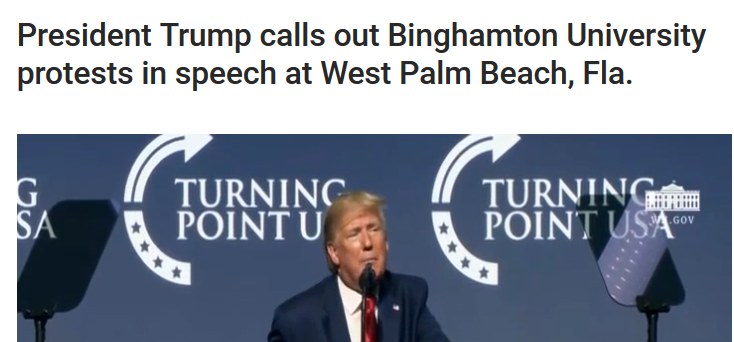
Mass expansion: the Stenger Years
Behind these episodic protests lurked a hidden, linear increase in mass policing on campus. What is most startling is the sheer growth of the Binghamton University Police Department (BUPD) in the last decade. The expansion of the force under President Stenger has far outpaced buildups in surrounding municipalities under even the most resolute law-and-order elected officials. For in ten years the BUPD force has increased in size by 50 percent:
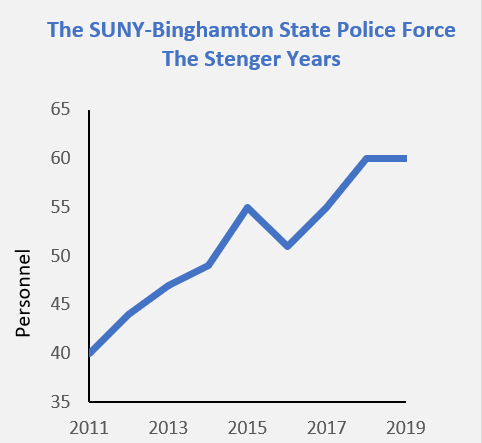
President Stenger now commands a state police force larger than any of the surrounding towns of Vestal, Johnson City and Endicott—and matches that of the larger City of Binghamton in the number of sworn officers who carry a firearm and can arrest persons, if not in total staff.
Just how disproportionate is the size of the SUNY-Binghamton force? In relation to residents it outweighs all the surrounding cities by a high margin:
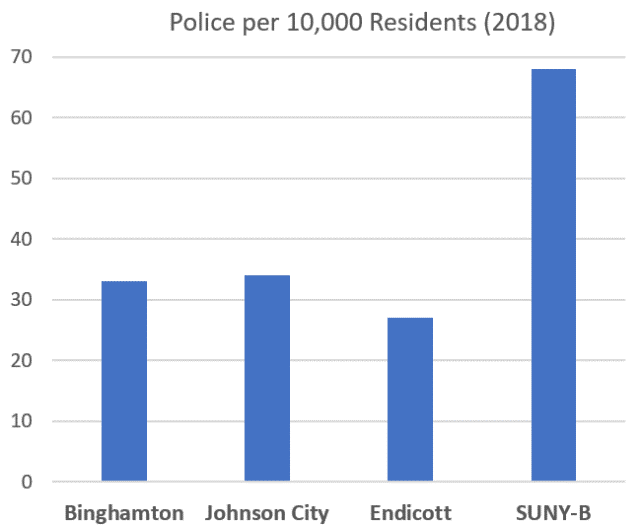
Crime and Policing
Equally puzzling are the workloads and outcomes of policing on this scale. Where is the crime and how is it policed? SUNY-Binghamton, like all universities in the nation, is required each year to report incidents of criminal acts to the Federal government and to place these on the campus website for students, parents, and others to read. To examine the latest report reveals a steady pattern: there is very little crime on the campus according to official reports.
For the main Vestal campus, the 2019 report lists no instances of domestic violence, no racial hate crimes, no arrests for alcohol offenses, two weapons arrests, and no motor vehicle thefts. There were eight rapes reported, five burglaries, two weapons arrests, two hate crimes related to sexual orientation and national origin, and the first murder on campus in many years. There were no criminal offenses officially at its downtown campus located in the heart of Binghamton.
What do campus police then do besides watch over protests, property and buildings? From official reports their main activity would appear to be referring students to disciplinary committees rather than local courts. There were 345 referrals for drugs and 352 for alcohol—offenses that in many cases would result in tickets and arrests in poorer areas of surrounding towns.
Policing the Colorblind Campus
What we do not know is the impact of this extensive campus policing. Did the fears of students twenty-five years ago of racialized policing come to pass?
The SUNY-Binghamton administration prides itself on its diversity and equity. Throughout campus posters of distinguished people of color proclaim “UDiversity.” The cost of senior diversity and equity administrators now easily exceeds $1 million annually. Yet in practice this appears to be a colorblind diversity, charting the good works of the institution while asserting the decline of racism and white supremacy. No evidence or data is provided towards these ends. Indeed basic information is hidden or purposefully not collected. It is exceedingly difficult to find publicly celebrated diversity plans despite every administrative unit officially having a diversity officer; a Freedom-of-Information request returned the response that no plans existed, even though a well-known if largely ignored study by Harpur College was produced in 2015.
Requests in recent years by students and faculty for an accounting of faculty diversity, especially faculty hiring, have yet to produce official replies. Letters, meetings, and protests by Black and Latinx students and faculty over racial harassment are a constant feature of almost every semester, and are offset periodically by official proclamations of concern, more training, and more committee work. With few racial hate crimes ever being reported by the police, despite the evidence, this has become a standard response. Still, a 2015 campus climate survey that probed racial tensions produced dismal results and has not been repeated—and has been removed from the campus website. Lacking faculty and counselors of color, students today turn to their peers for assistance.
Similarly, when the campus newspaper reported in fall 2017 that the first-year enrollment of new Black students had fallen by 20%, there was no comment; for decades Black students have constituted only between 4 and 5 percent of the undergraduate student body.[7] For an institution that promotes itself as the “Premier Public University,” this seems remarkably low. Public schools in its main recruiting areas in the state are far more representative, with New York City’s public schools being 26 percent Black and Binghamton High School being 26 percent Black. Increased diversity officers and multiracial committees appear to have a negative relationship, if any, with the numbers of students and faculty of color.
Policing and its relationship with racial and gender representation and inequalities remains equally impenetrable. The university reveals neither the diversity of the force over time nor its budget. No records are kept of stops by race, ethnicity, or gender. The campus administration has rejected equipping officers with body cameras.[8] No records are kept on the number of students of color who have been referred either by the police to disciplinary committees on campus or by unknown faculty to be monitored as “persons at risk.”
One data set does exist: the number and nature of arrests by campus police. These are spotty and uneven data. Here as elsewhere official, standardized data would be most welcome. What I have for 2016 from a Freedom-of-Information request is hardly encouraging: Black students are heavily, disproportionately, arrested by comparison to all other ethnic and racial groups on campus no matter how charted:
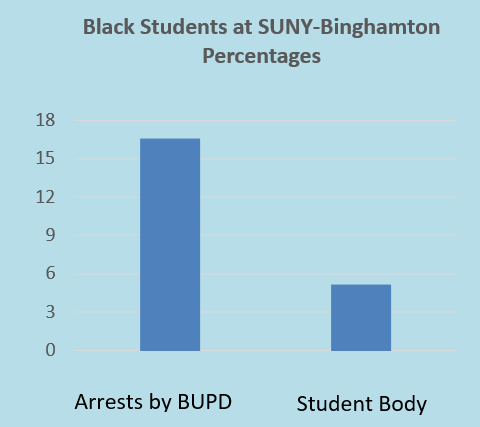
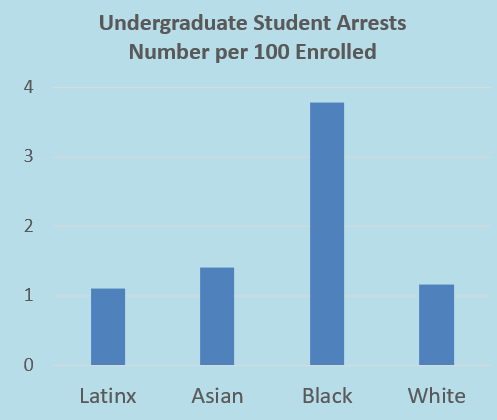
This is a highly gendered police practice: Black men constitute 90 percent of the Black students arrested.
Defund or Dismantle?
The Black Lives Matter rebellion has openly instigated a debate over the defunding and radical shrinking of municipal police forces. The long record of campus policing at SUNY-Binghamton underpins this call for the campus community. Based on the historical record outlined here, and the thin data that the administration has revealed to date (often under the pressure of Freedom on of Information Act requests), the SUNY-Binghamton police force cannot be legitimized by its purported anti-crime activity, an ability to provide safety especially for Black campus residents and staff, or its relation with racial harassment and inequalities in the campus criminal justice system. There is no independent oversight, and lines of authority between police officials and the administration are excessively close and opaque. Indeed, as elsewhere, greater security would be provided by downsizing the campus’ private police force and investing the funds elsewhere. Less police would mean more safety. But we need more. It is time to begin a conversation on how to disarm and dismantle the campus police and construct a representative safety organization, designed by and accountable to the community.
Endnotes
[1] “Students Protest Arms Recommendation,” Newspapers.Com, December 4, 1992.
[2] Mitchell Berger, “Year in Review,” Binghamton Review VI, no. 1 (Orientation 1993): 9, citing a December 1992 Pipedream editorial.
[3] Joe Martn and Paul Torres, “A Campus Up in Arms,” Binghamton Review, December 1995, 5.
[4] Editorial, “Arm SUNY,” Press & Sun Bulletin, February 4, 1996.
[5] As public libraries and archives reopen, this history will be updated.
[6] “So earlier this year, at Binghamton University, a few conservative students were promoting an event featuring the renowned economist at Art Laffer… They were surrounded by hundreds of radicals, screaming at them in vile terms… A mob flooded the place wearing masks and red armbands, and acting tough. They swing clubs. They swing bats. They swing everything.” No bats or clubs were ever seen by anyone. “Remarks by President Trump at Turning Point USA Student Action Summit | West Palm Beach, FL,” The White House, accessed June 14, 2020, https://www.whitehouse.gov/briefings-statements/remarks-president-trump-turning-point-usa-student-action-summit-west-palm-beach-fl/.
[7] “The racial composition of BU hasn’t changed much since the class of 2010 was admitted, when 6 percent of students identified as black or African American. In this year’s class, just 4 percent of freshmen identify as black. Among all SUNY institutions, the percent of students who identify as black is 10.8 percent.”
[8] David Julien, “BU Police Choose Not to Implement Body Cameras despite SUNYSA Resolution,” UWIRE Text, May 9, 2019, Gale OneFile: News.
Leave a Reply